This rhubarb shrub makes a really nice and simple spring cocktail when you mix it with ice, gin, and soda water. I recommend adding a sprig of thyme for extra spring freshness. Rather than talk your ear off about it, I’ll just leave the recipe here, encourage you to give it a try, and walk back to my Saturday afternoon gin drink in the yard…..
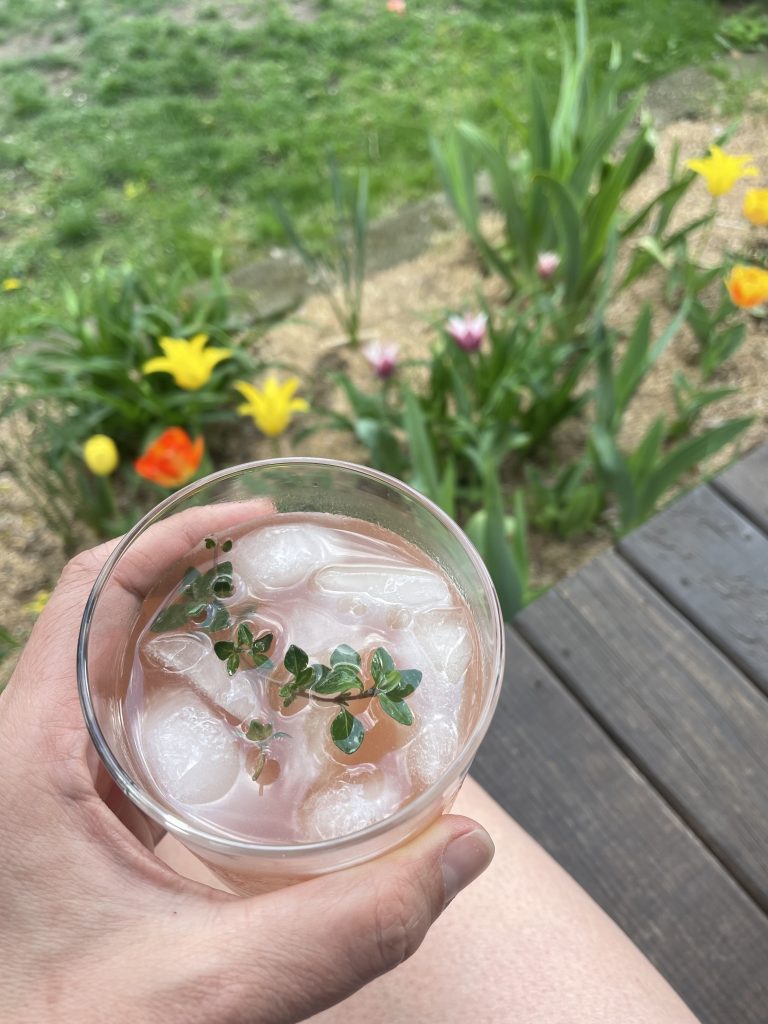
Rhubarb Shrub
Makes about 2 cups
Ingredients
1 pound rhubarb (about 4-6 stalks), roughly chopped
1 cup sugar (maple sugar or 1/2 cup maple syrup work great too)
1 cup water
1 cup apple cider vinegar (I hear red wine vinegar or balsamic are good too, but I haven’t tried them)
Instructions
- Bring rhubarb, sugar and water to a boil in small saucepan. Reduce heat to low and simmer 20 minutes.
- Take off the heat and add the apple cider vinegar. Let cool.
- Strain through a fine mesh sieve (you could use a cheese cloth or clean towel if you need a finer mesh)
- Chill and Enjoy!
This should last just fine in the fridge for a month or so, but I dare you to resist drinking it for that long! I like to add a tablespoon or two to each drink, but you might like more or less.
]]>As you know, I’m currently obsessed with sugar snap peas. They’re coming out of my backyard vegetable garden by the pound right now… we’re picking every other day and getting a pound each time! So I’ve had a lot of peas to experiment with. My other favorite recipe is this sugar snap peas salad.
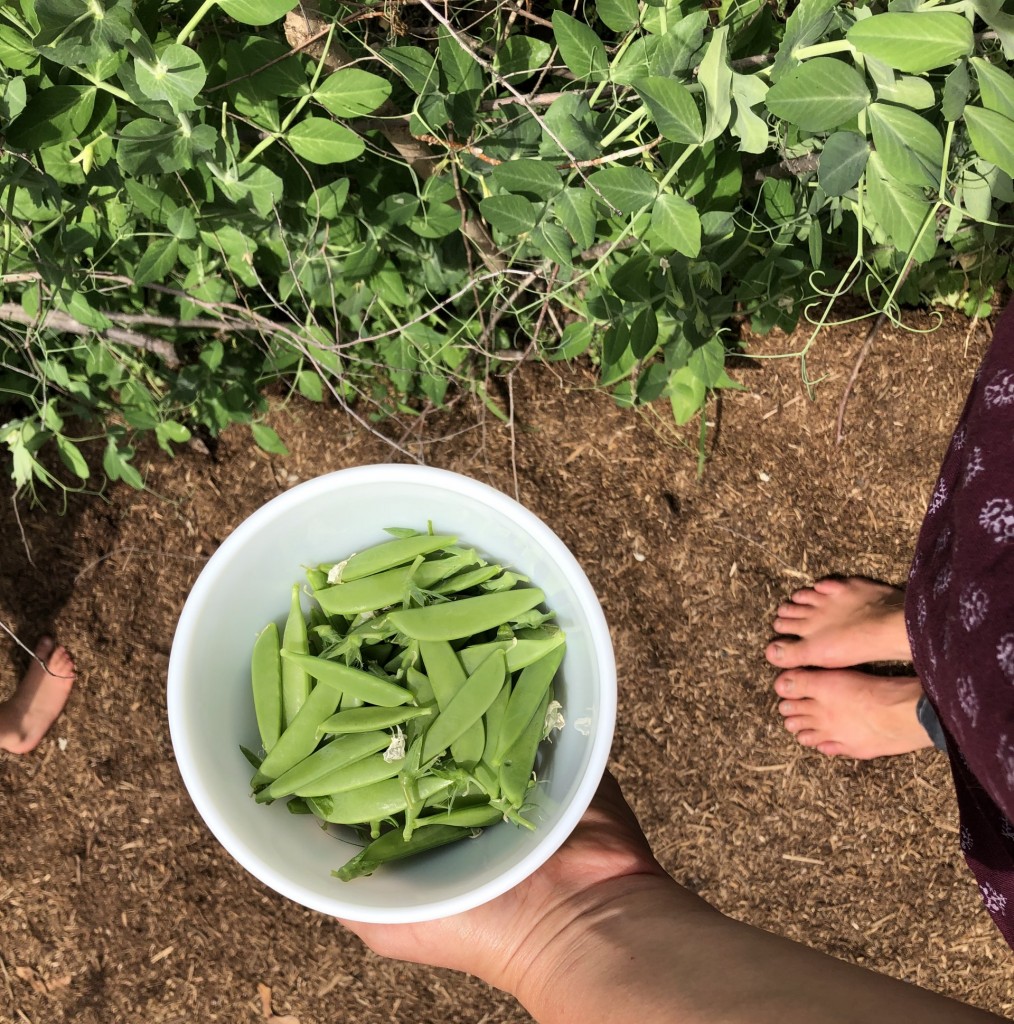
This is our second favorite recipe so far. I love it for two reasons:
- I love any recipe that incorporates my homemade yogurt, especially if its a savory recipe that lets me eat yogurt for dinner!
- Similarly, I love to put delicious toppings on garlic toast! The simplicity of a fancy open face sandwich really makes me happy.
Dilly Beans and Sugar Snap Peas on Toast
adapted slightly from Bon Appetit
Ingredients
1½ cups plain, whole-milk yogurt, drained*
1 teaspoon salt
1 lemon, juice and zest
2 Tablespoons apple cider vinegar
2 teaspoons Dijon mustard
1 teaspoon black pepper
1/4 cup olive oil, plus more for toast
4 chives
8 oz. sugar snap peas
1/2 cup dill
1 14.5-oz can cannellini (3/4 cup dried beans)*
4 slices crusty bread
1 garlic clove
Assembly
- Preheat oven to 400F
- Using a fine mesh sieve, drain your yogurt. Once it’s drained, pour it into a bowl, add lemon zest, and stir to combine.
- In a large bowl, whisk lemon juice, vinegar, Dijon mustard, 1 teaspoon salt, and ¾ teaspoon pepper.
- Whisking constantly, slowly stream in ¼ cup olive oil until dressing thickens slightly and no longer looks oily. You want to add the oil gradually so that your mixture will be creamy and emulsified.
- Trim chives and slice thinly crosswise. Add to bowl with dressing and stir to combine.
- Trim ends of peas and cut on a diagonal into ½” pieces (about the size of your beans) and add to bowl.
- Finely chop dill and add to bowl.
- Drain and rinse beans, then add to bowl with dressing.
- Toss until well coated. Taste and adjust seasoning, adding more salt if needed.
- Place bread on a baking sheet, drizzle (both sides) with olive oil. Toast bread in the oven, finishing on broil if needed to make them extra crispy.
- Rub both sides of the bread with garlic clove; season with a little salt.
- Divide yogurt mixture among toasts. Spoon peas and beans over. Don’t leave any vinaigrette behind: Divide any leftovers among toasts.

I’m still on the lookout for great pea recipes, so please tell me how you’re using them and send me your favorite recipes in the comments below!
*Recipe Notes:
- You could use greek yogurt or ricotta instead of draining whole-milk yogurt. The original recipe calls for ricotta, which I never have in my fridge. On the other hand, I make my own yogurt every single week, so I’ve always got plain, whole-milk yogurt.
- I almost always cook dried beans in my instant pot. If you’re like me, you’ll need to cook 3/4 cup dried beans for 40 minutes in the instant pot.

A few years ago, I sewed a bunch of reusable cloth gift bags in cheerful Christmas patterns and they continue to bring me such joy!
I love wrapping presents in these gorgeous bags. I love giving them to people (and am so honored when friends and family want to keep the bag in addition to the gift… in fact, you’ll regularly find me sneaking around and gathering my bags up after gift opening is over at our family gatherings). I love reusing them year after year!
AND they’re super easy to make! I swear, they’re a great project for beginner sewers because it doesn’t matter the size, shape, or even if they’re particularly square. The process is three simple steps: cut, sew, enjoy!
Step 1: Cut your fabric
If the exact size/shape isn’t important to you, I recommend letting your fabric dictate the size.
For example, my fabric is almost 42 inches wide, so I cut it exactly in half and made two 10 inch wide bags. I cut my fabric 15 inches tall and ended up with two 10”x13” gift bags. I love using printed fabric like this because it makes straight cuts easier. I pick a spot in the pattern and cut right along the “line”.
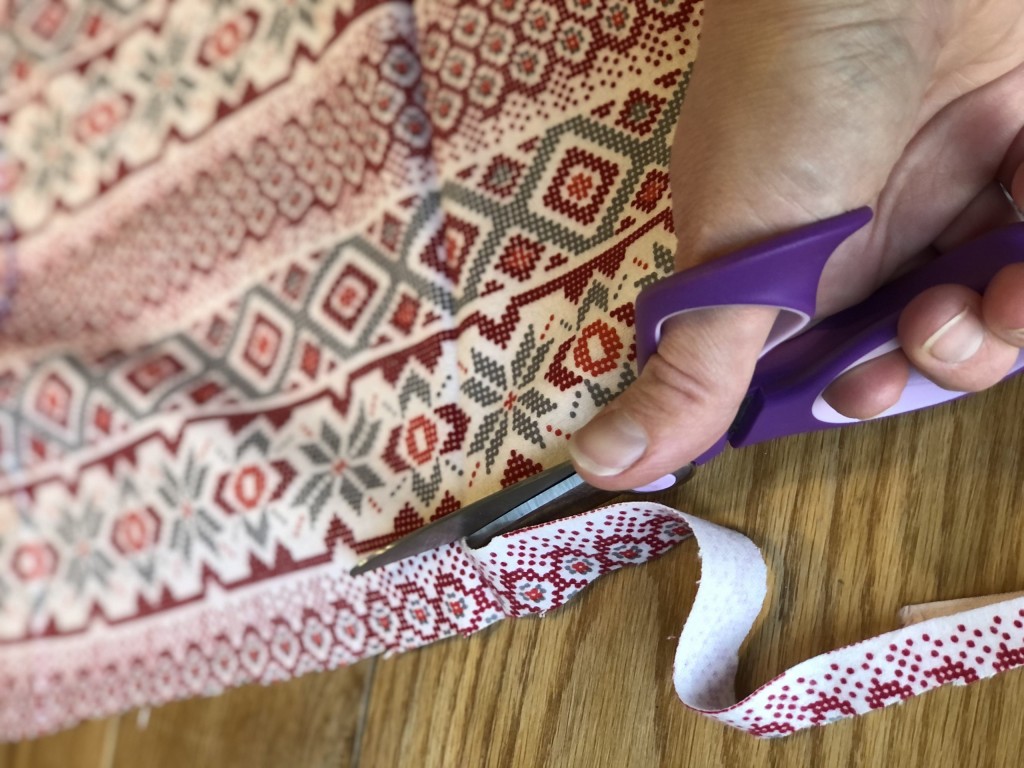
After cutting, my fabric is about 21 inches wide and 15 inches tall.
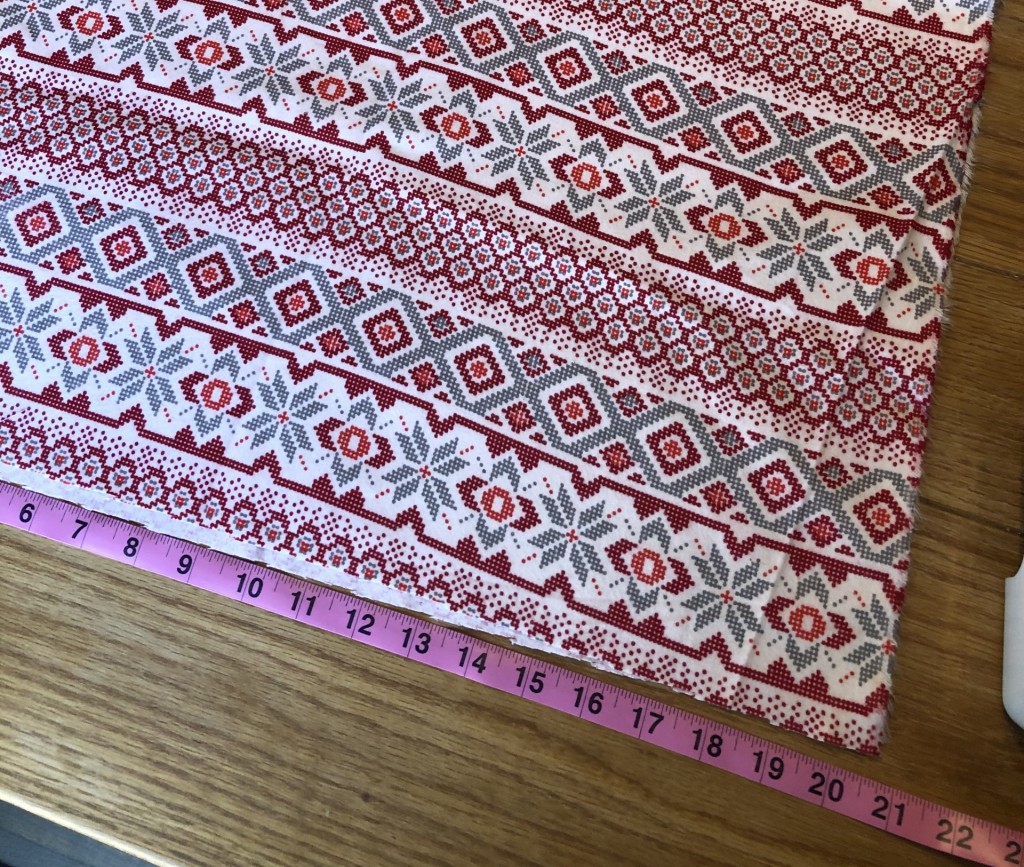
Step 2: Cut your cord
I used 1/4” cotton cord, but feel free to use bigger or smaller. Choose the top of your bag (based on the pattern) and cut your cord at least 8-10 inches longer than the width of your fabric (it will hang out 4-5 inches on either end when you’re done).
My fabric is 21 inches wide, so I cut my cord about 31 inches long.
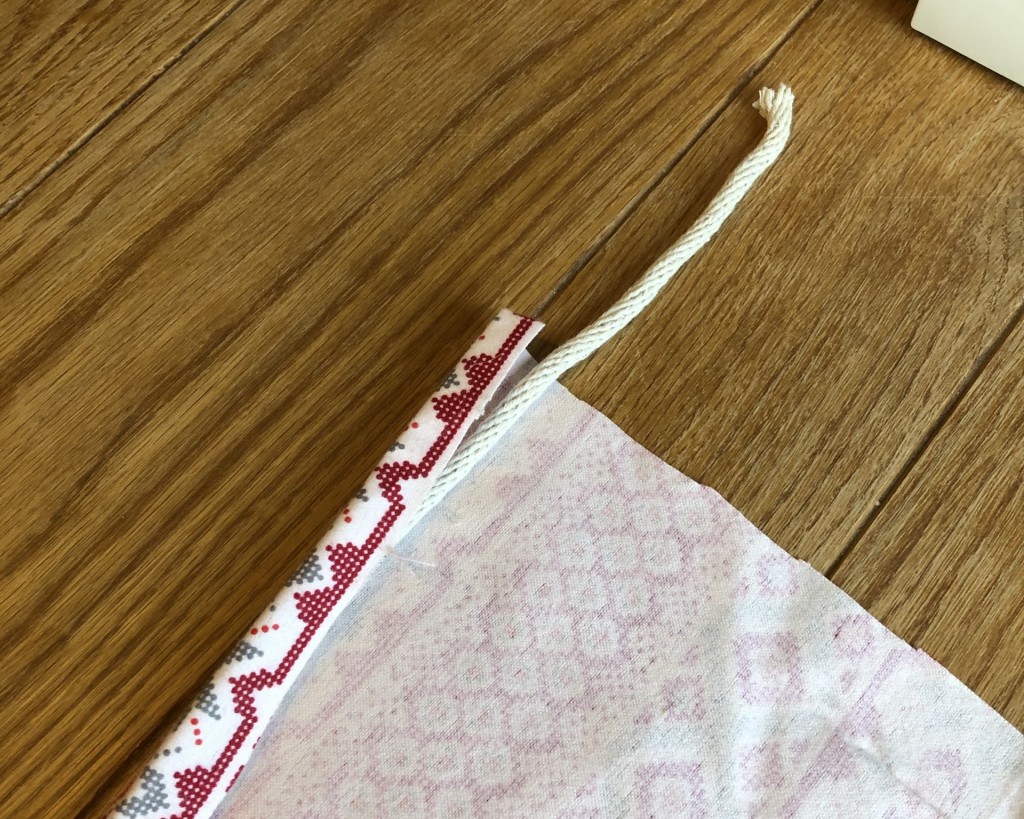
Step 3: Sew your cord into place
Place your fabric with the wrong side up* and the top pointing away from you. Place your cord along the top edge and fold the top of the fabric towards you. You’re going to sew a little pocket for the cord to slide through, so make sure there’s enough fabric that you can run your foot** along the seam without stitching the cord.

* the “wrong side” is what we call the back of your fabric, the side without the pattern, the side you want on the inside of your bag. ** the “foot” is the mechanism around the needle on your sewing machine as shown in this photo.
Step 4: Sew the other two seams
Keeping the wrong side up, fold your fabric in half. This will be the final shape of your bag, so the cord should be at the top and you should have seams to sew across the bottom and one of the sides. Trim any excess fabric if your edges aren’t lining up.
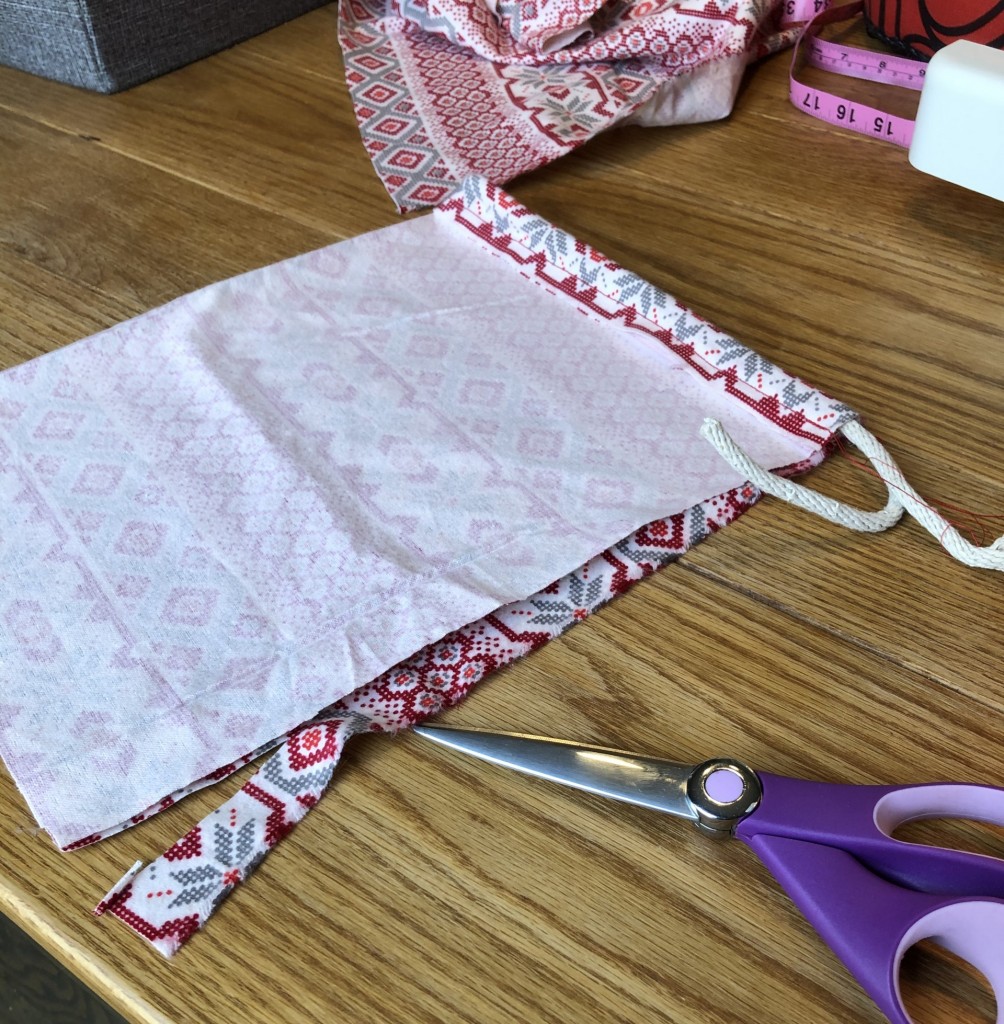
Go ahead and sew these seams. The only tricky part is making sure you don’t sew through the cord/pocket. If you do this, you won’t be able to pull the cord to cinch the bag closed.
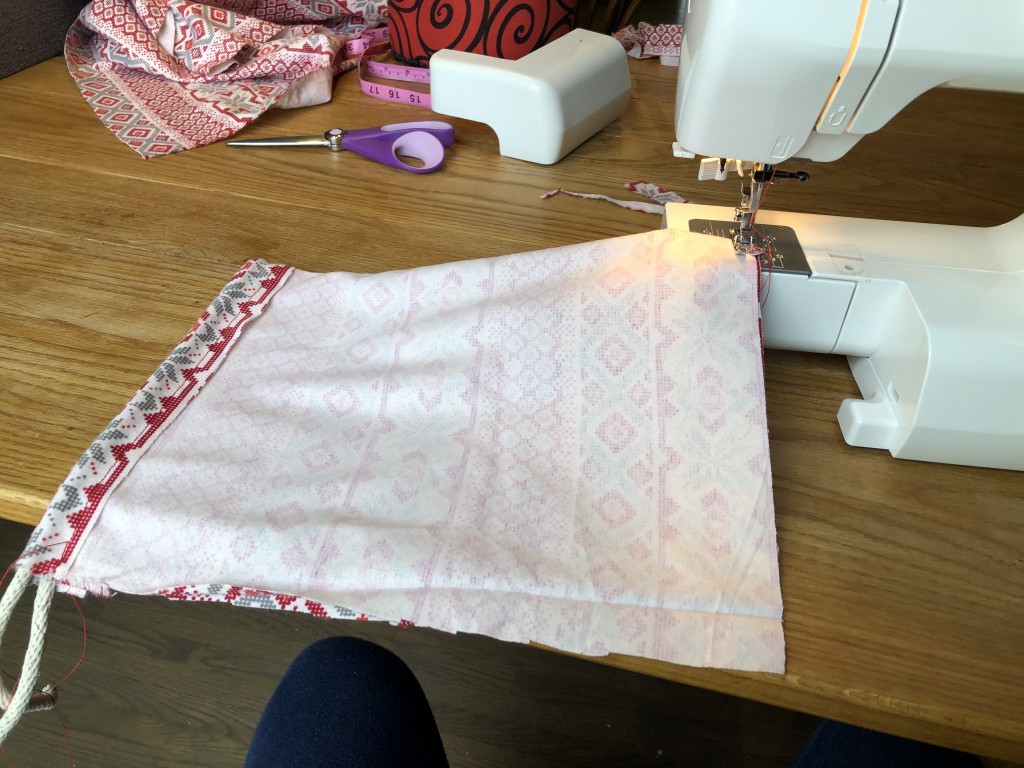
Trim extra thread and turn your bag right side out.
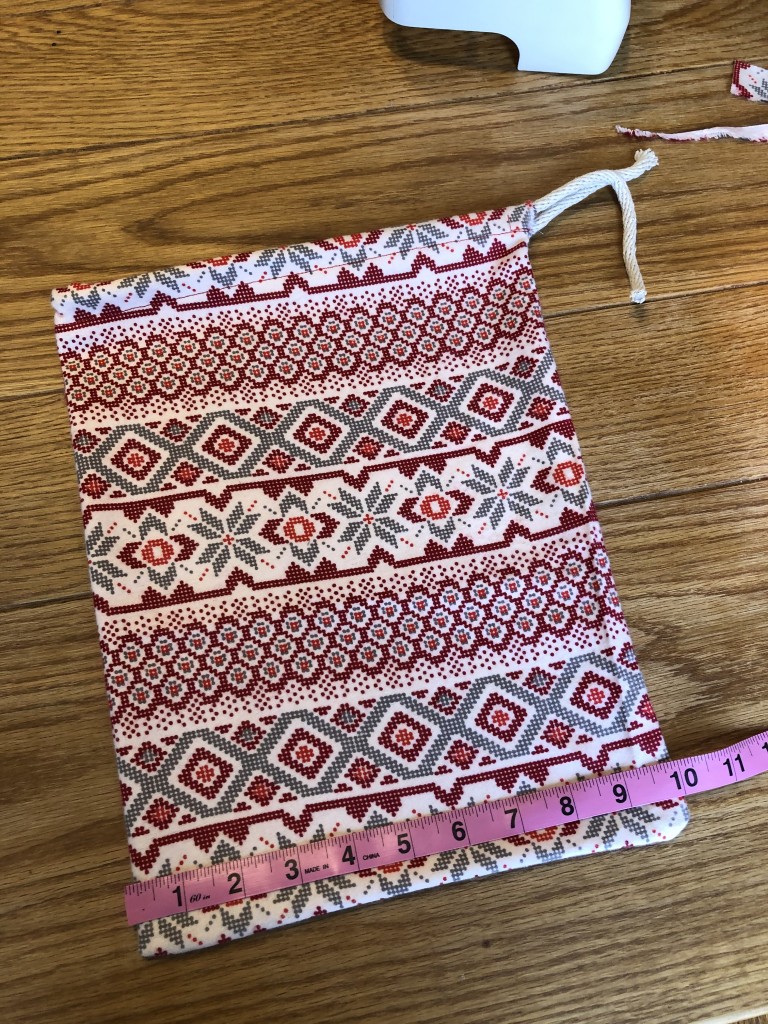
Step 5: Tie knots at each end of the cord
This will prevent the cord from accidentally getting pulled into the pocket when someone is opening their gift. Fishing the cord back out is certainly possible, but a royal pain.
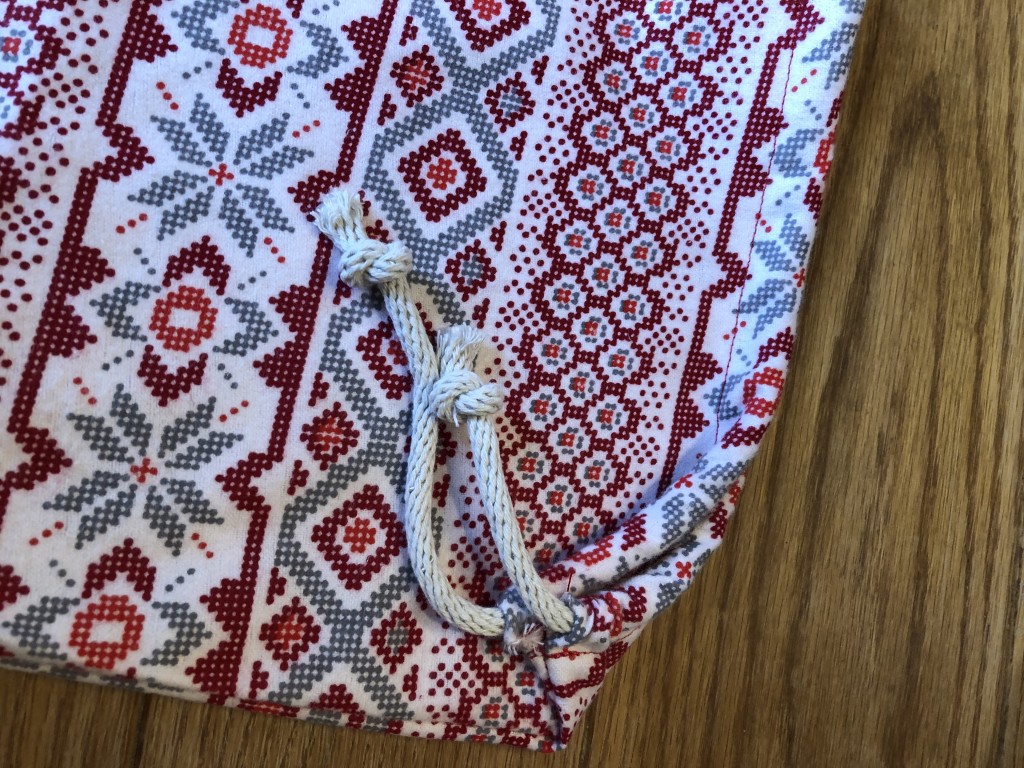
You’re done! You can make as many bags as you want, in a myriad of sizes to meet your gift giving needs!
I have about 24 bags total and the “10×13” bag I made today is the “medium” size bag in my collection. I have a bigger size (roughly twice as big) and a smaller size too. Three yards of fabric will yield about 8 medium and 2 large bags. I like to mix and match my colors and patterns, so I’ve purchased different patterns over the years.
Please drop your questions in the comments below. I’m always happy to answer questions!
And comeback to tell me about your experience if you’re making these reusable gift bags for the first time. I can’t wait to hear about your project!
PS. Does this post feel familiar? It should! It was originally posted a couple of years ago. I’ve updated and republished it because it’s one of my favorite posts.
]]>Most of us firmly believe that one is “better” than the other, but there’s a really interesting debate about the sustainability aspects of this tradition. Here are a few pros and cons to consider when choosing the type of tree you use to celebrate the holidays.

Natural Trees
PROS
- The trees provide many benefits to the environment as they grow, cleaning the air and providing watersheds and habitats for wildlife.
- They are a renewable resource and replanted after being cut.
- They grow best on rolling hills that are often unsuitable for other crops.
- When you buy a tree from a local farmer, you’re supporting the people who live in your community.
- Trees are biodegradable and can be composted, mulched, or burned.
- The British Carbon trust estimates the average carbon footprint of a natural tree is 3.5kg of CO2 when composted, mulched or burned.
CONS
- Buying a tree every year can get very expensive. According to Consumer Reports, the average cost of a natural Christmas tree in 2020 was $81.
- Not everyone has access to local Christmas trees and transportation contributes to the environmental impact of your tree. If you drive more than 10 miles to get your tree, it might be more environmentally friendly to purchase an artificial one.
- Not everyone has access to tree recycling programs. In the UK, an estimated 7 million Christmas trees are landfilled each year.
- The British Carbon trust estimates the average carbon footprint of a natural tree is 16kg of CO2 when composted, mulched or burned.

Artificial Trees
PROS
- The average artificial tree costs $107, making it the economical choice in the long run.
- Caring for your tree and extending its use beyond the average seven years will certainly reduce the environmental impact.
- Reselling, gifting, or donating your tree when you’re done with it will help extend the life.
- If you use your tree for 12 years or more, you might actually have less of a carbon footprint than a natural tree.
CONS
- Most of the artificial trees on the market are made of PVC and steel in China and shipped to the United States.
- Artificial trees are used for an average of 7 years before it is disposed of. If a tree is displayed for 1 month/year, it will have served as a Christmas tree a total of 7 months.
- Most artificial trees cannot be recycled at the end of their life.
- The British Carbon trust estimates the average carbon footprint of an artificial tree at 40kg.
My vote? Team Natural!
My family sits squarely on Team Natural. In fact, we choose to hunt for our Christmas tree in the National Forest each year and it’s one of my favorite family holiday traditions! We love the adventure of wandering through the wild forest, foraging for the “perfect” Christmas tree.
Did you know you can harvest a Christmas tree from the National Forest? You can! And in Michigan, the permit is only $5. Read more about my tips and recommendations for a successful Christmas tree hunt in the national forest here, in this updated blog post.

Let’s Recap
If you’re going to buy a natural tree, buy local from a tree farm or retailer (preferably less than 10 miles from your home) and don’t throw your tree in the trash after the holiday.
Lots of municipalities have specific days for curbside recycling of Christmas trees. Alternatively, you can put it in your yard waste container, drop it off at a local recycling center, or let it naturally biodegrade on your own property if you have the space.
Birds and small mammals love the extra shelter and you’ll be shocked how quickly the tree decomposes. Usually, your county/city will share this information right after Christmas. Please feel free to share a link to your county/city tree recycling program in the comments. I’m sure your co-workers will appreciate it!
If you’re going to buy an artificial tree, buy the most durable one you can find (look for warranties) and keep it as long as possible.
For all this debate, it’s worth maintaining the perspective that no matter which you choose, your tree has a climate impact equivalent to driving roughly between 10-20 miles. So, bike to work a few days a year, and you’ve already offset your tree, no matter which type it is.
What about you?
Are you on Team Natural? Feel free to share your favorite local tree farms in the comments.
Are you on Team Artificial? Who’s had their artificial tree the longest? Anyone over 10 years? 20 years? What’s the sturdiest model available?
Here are links to my sources if you’re interested in digging deeper.
https://www.sightline.org/2015/12/21/your-christmas-trees-carbon-footprint/
https://www.nytimes.com/2018/11/26/business/energy-environment/fake-christmas-tree-vs-real-tree.html
https://www.independent.co.uk/environment/christmas-trees-recycling-environment-sustainability-plastic-a8705081.html
https://www.carbontrust.com/news/2013/01/christmas-tree-disposal-advice/
https://www.in.gov/dnr/forestry/7561.htm?fbclid=IwAR3PlYxqOFDnWILG7ej8_BPRSsCPhO2LjGq2L9dZ3gXqwh7NKeu55LX53eY
https://www.thinkstep.com/content/study-comparative-life-cycle-assessment-artificial-and-natural-christmas-tree
]]>
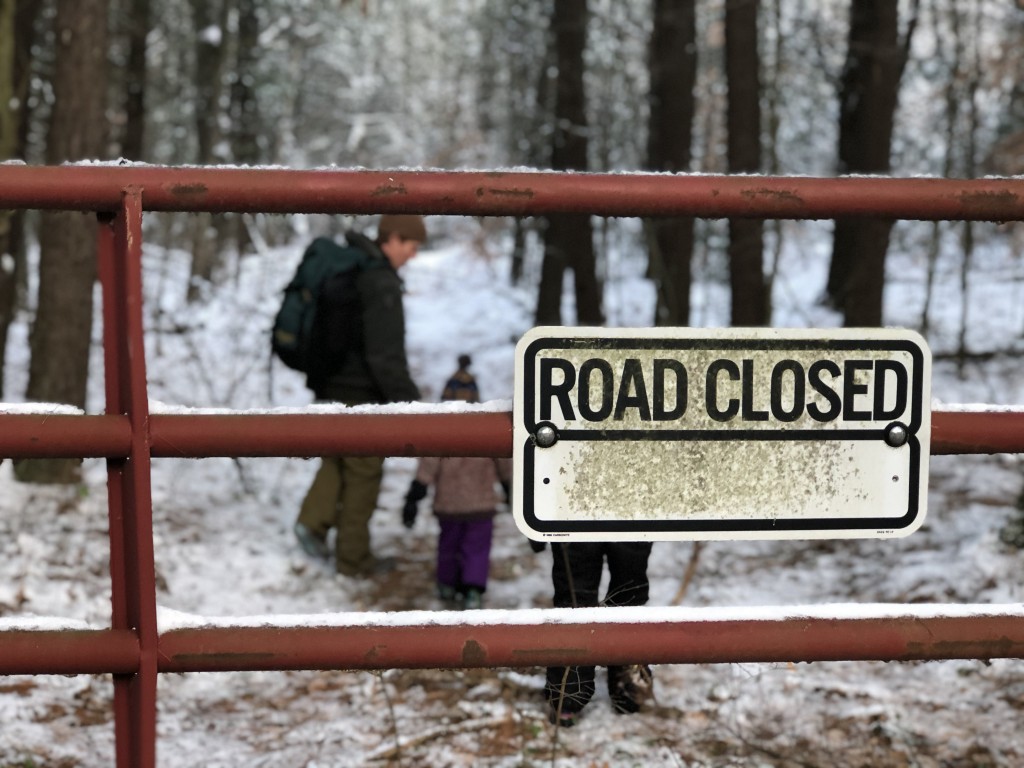
This is one of my FAVORITE family holiday traditions! We love the adventure of hunting for our Christmas tree in the natural woods! We pack hot chocolate and marshmallows, and make an afternoon out of it!

To be clear, my Christmas tree does NOT look like the $50 version many of us are used to buying from a tree lot. It’s hard to find a small, bushy tree (remember, we’re talking about a natural forest here), but I LOVE the entire experience and wouldn’t trade it for the world.
By harvesting a tree from the National Forest, I’m contributing to the overall forest health. As highlighted on recreation.gov, “Christmas tree permits are a unique opportunity for citizens to help thin densely populated stands of small-diameter trees – the perfect size for a Christmas tree.”
Ready to plan your hunt?
For a great day of family fun while hunting for a Christmas tree hunt in a National Forest near you, I recommend the following preparations:
- Plan to spend the whole day, don’t rush. One year, we tried to cram our Christmas tree hunt into an afternoon and ended up hunting well into twilight and hauling our tree out of the woods in the dark! Don’t get me wrong, we still had an amazing time, but I would have enjoyed it even more if we’d had more time for our fireside picnic. And, especially if this is your first time… it will take longer than you think.
- Pack a picnic. We love to bring snacks, hot cocoa, and s’mores supplies. Especially if it’s cold, we sometimes build a little campfire to warm our fingers and toes (of course, we make sure to build it in a safe spot and extinguish the fire completely before we leave). We try to move slowly through the adventure, making time to enjoy the woods before cutting our tree and coming home.
- Review the maps provided by your local organization to make sure you know where you are, and more importantly are not allowed to cut a tree. Be a good citizen and pay attention to private property signs. In Michigan, small parcels of private property and National Forest land are often intermingled. It’s also helpful to review aerial maps (on google) ahead of time to look for heavily forested areas and to identify areas with conifers.
- Take some printed maps along on your adventure. Sometimes our day proceeds exactly according to plan, but more often than not we have to adjust our plans along the way. We regularly find ourselves without cell service at various points during our hunt and are always grateful to have printed maps. We have an atlas that covers the whole of southern Michigan. We also print maps from recreation.gov to make sure we have the most updated information. If you live in Michigan, here are some additional maps to reference:
https://www.fs.usda.gov/Internet/FSE_DOCUMENTS/fseprd536815.pdf
https://www.fs.usda.gov/Internet/FSE_DOCUMENTS/fseprd536816.pdf
- Brush up on your tree identification skills. Your National Forest may limit the specific types of trees you’re allowed to harvest for your Christmas tree. If you’re not 100% confident in your tree identification skills, bring a book along with you!
- Consider buying two permits. If you have enough space in your home, think about buying a second permit so the kids can select and bring home their own tree. Crafting a love of the forest and outdoor adventures is a key point to this adventure for Robbie and me. You should see the pride in my girls’ faces as the find the perfect tiny tree for their bedroom. They name the tree, they carefully carry her to the car, place her in their shared room, decorate her with their favorite ornaments (she’s so small, it really only takes a few lights/ornaments and you could easily use paper chains and other homemade decorations if you don’t have extras), and water her every day. I said “no” to a second tree for years and I’m so happy I finally realized how much extra fun it could add to our adventure.
- Get ready for a fun family adventure!
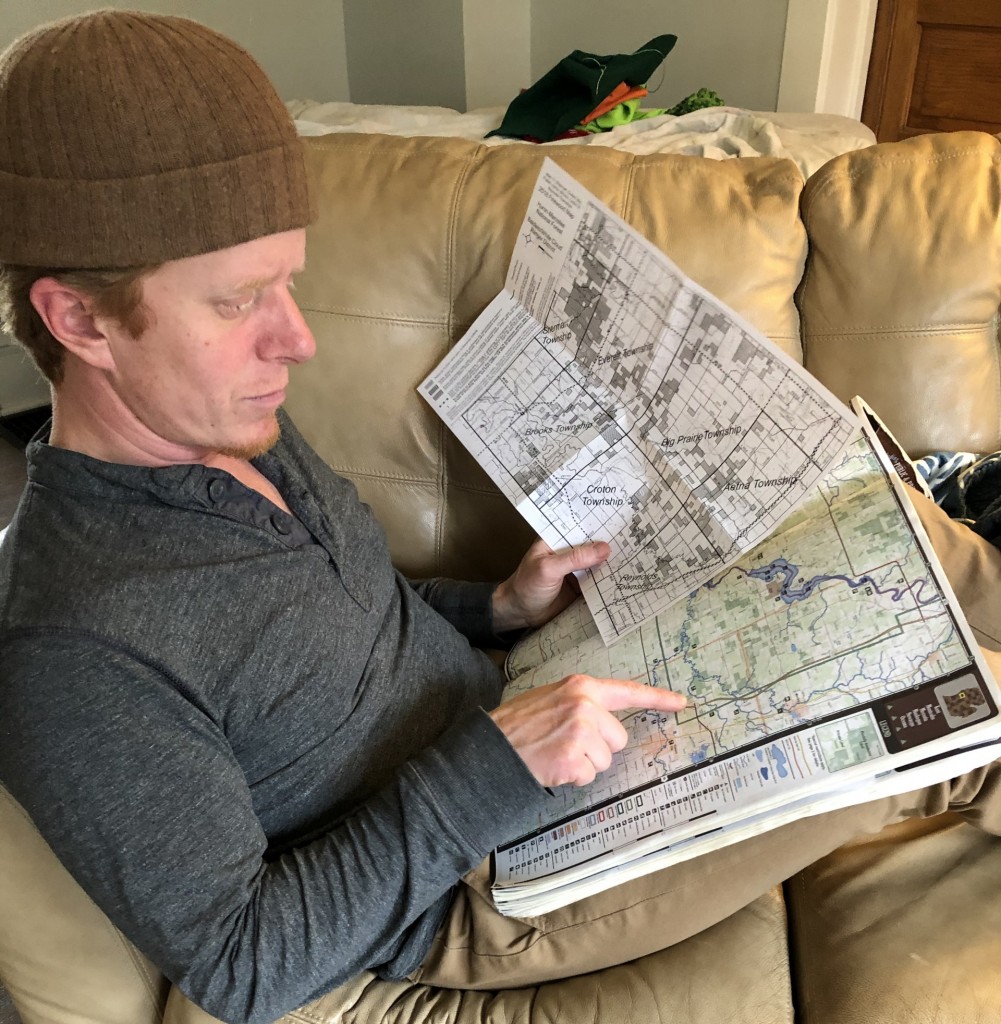
Ready to buy your permit? It’s a quick and easy process! Here are a few tips:
Visit Recreation.gov for more information and to buy your permit online. It’s really quite easy! The website will help you through the following steps.
Choose Your Forest
Determine which participating forest works best for your Christmas tree outing. Each forest will have specific guidelines and season dates for cutting a holiday tree.
Get the Details
Be safe and prepared. Carefully read the details and rules of your permit, and follow the Need to Know suggestions to prepare for your visit.
Buy a Permit
Purchase and print your permit so you’re ready to find your perfect holiday tree.
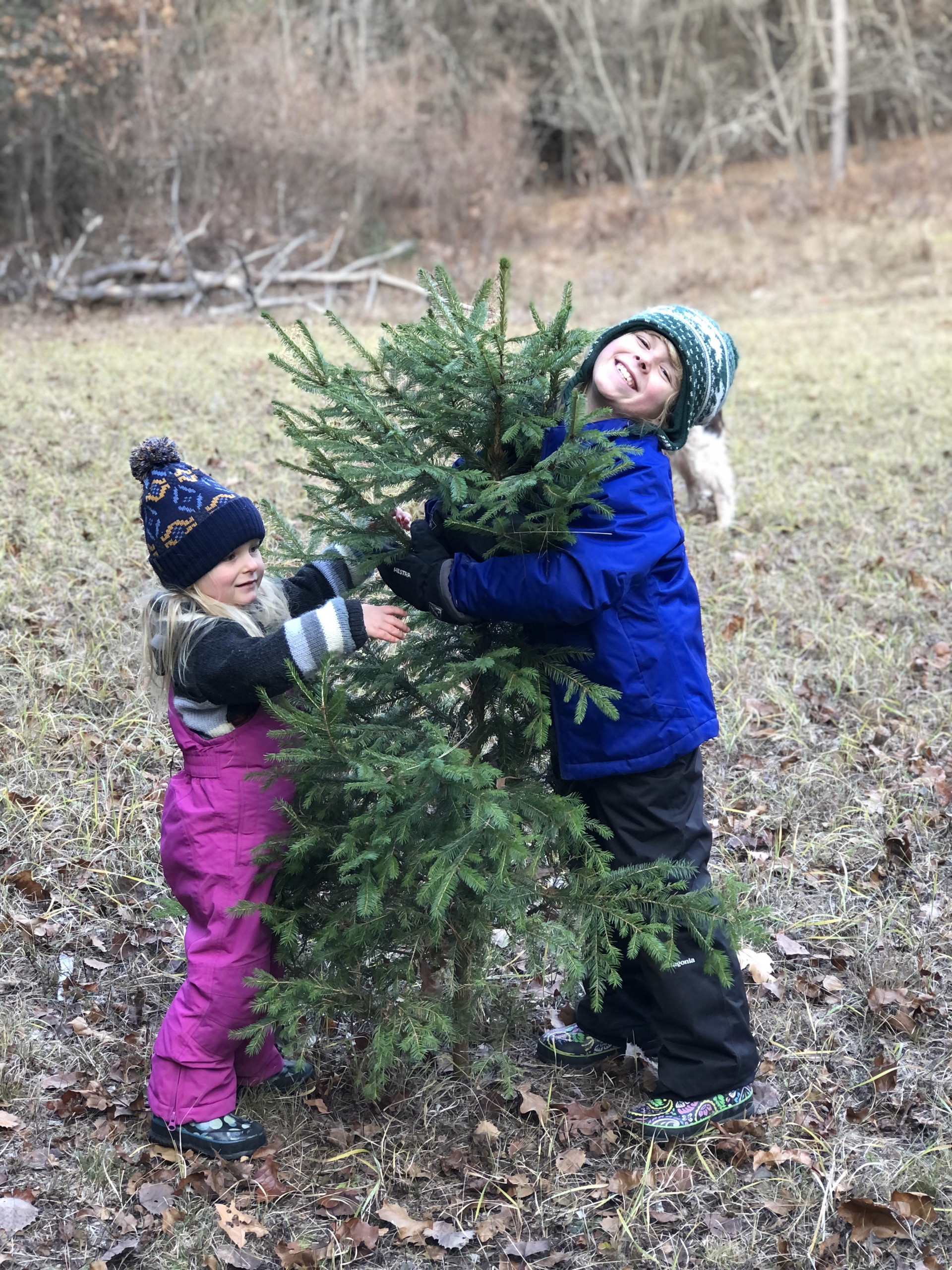
I can’t wait to hear about your experience harvesting a Christmas tree from a National Forest near you! Please share your experience, stories, and recommendations!
PS. Does this post feel familiar? It should! It was originally posted a couple of years ago. I’ve updated and republished it because it’s one of my favorite posts.
]]>
A few years ago, I bought a bunch of flannel fabric in adorable holiday prints and sewed up a whole pile of reusable gift bags. This year, I’m honored that my tutorial was selected to be included in the winter edition of the Simple Living Collection!
The Simple Living Collection is a digital bundle of resources to help you settle into a slow and intentional life, reconnecting with each other and nature, and embracing this magical wintery time of rest. There are 70+ tutorials, recipes, ebooks, stories and other activities from more than 50 contributors, just like me. It’s on sale for $25 until Monday, December 13th. Available for immediate download, the PDF is yours to keep and revisit year after year for inspiration. If you’re interested, you can buy your copy here!
The Collection is divided into seven different sections to help families build their own slow-living resource binder. Grow, Raise, Create, Nourish, Healthy Home, Wildcraft, and Family. I’m so excited to share a few of my favorites from each section with you!

This is my favorite section, full of seasonal and holiday crafts! Simple ones that will make for a joyful hour with the kiddos and longer projects to sink deeply into on a slow and quiet morning by the fire. My favorites include:
- Salt dough ornaments from Heather Turner @thehomespun.mom
- Felted fingerless gloves from Emma-Lisa McGee @ourhomeonthehill
- Evergreen dish tutorial from Tara Rondinelli @littlepinelearners
- Natural winter village from Naomi Noyes @ninos.and.nature
- Winter solstice garland from Angela Ruggles @the.nature.atelier
- and MY reusable gift bags!

These three sections combine so nicely to help you feed your family with simple healthy food (hello, micro greens! and I think the extracts make perfect gifts) and sweet treats for your holiday special occasions. My favorites include:
- Homemade extracts from Christy Rucker @christyrucker
- Skillet star bread from Cassandra Evans @northwoodsfolk
- Cardamom sourdough cinnamon rolls from Tess Czulinski @naturally_tess_
- Microgreens made easy from Joey Hodlmair @destinationmommy
- Shiitake log tutorial from Roxanne Ahern @happyholistichomestead
- Winter chicken care from Ashley Comer @slowlivinghomestead
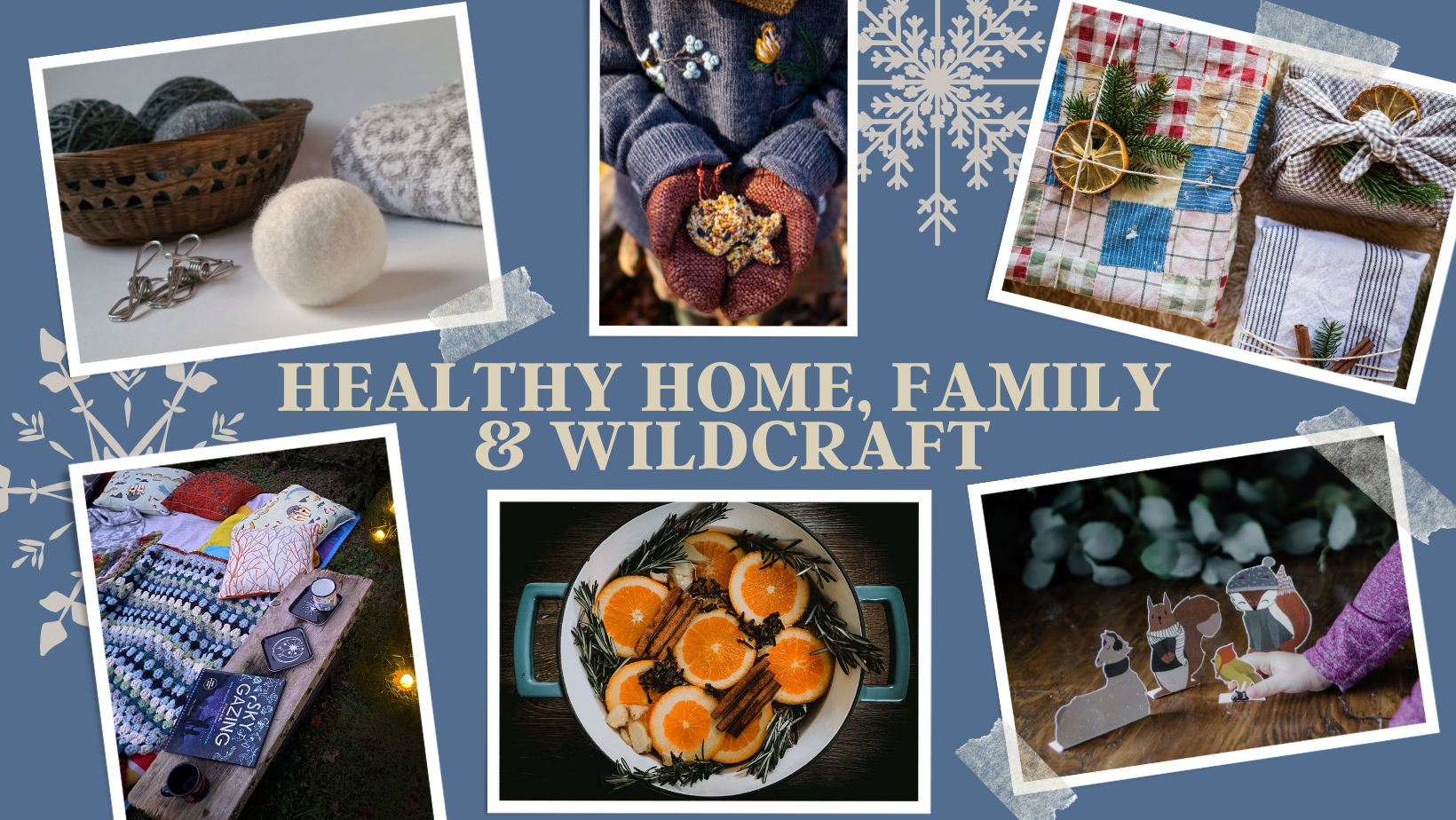
Last, but certainly not least, here are a few of my favorites from the healthy home, family, and wildcraft sections of the Collection. The family section, especially, has lots of fun stories, games, and activities to play with your children, grandchildren, nieces and nephews, or visiting friends with kids during this winter season. There’s plenty here to keep you all entertained!
- Wool dryer balls from Harmonie O’Loughlin @florasfeastbotanicals
- Seasonal simmer pot recipe from Kaila Addis @wildmamarising.ct
- Sustainable gift wrapping (no sewing required!) from Ashley Comer @slowlivinghomestead
- Winter Solstice Guide from Jessie Lehson @wineberryadventurescouts
- Birdseed ornaments from Mari Johnson @bellamartinelli
- Winter puppets from Millie Hernandez @forest.roads
These are only a sampling of the phenomenal work put in by all of the wonderful contributors in this community effort! I’m so excited to be a part of it. The Collection is on sale for $25 until Monday, December 13th and you can get your copy here!
]]>
I hear you… “ok, Erin, but after I’ve roasted and frozen them, what do I DO with all these beautiful red peppers?”
Let me introduce you to my FAVORITE fall soup: Roasted Red Pepper Curry Soup. It’s easy to make, gluten free, dairy free, and EVERYONE in my family is happy to eat this meal! This recipe works well with roasted red peppers from a jar if you’re short on time or you could follow steps 1 and 2 below with just 3 or 4 peppers if you want to make a batch of soup today (and skip the freezing all the peppers step).

One of the things I love about this recipe, is the ability to customize your bowl with your favorite toppings. In my house, this type of approach is key to finding a dinner everyone loves. Robbie and I love adding thai basil from the garden, a swirl of sriracha, and chopped up pistachios for a little spicy crunch. The kids love fried tofu and rice noodles. The combinations and possibilities feel endless! If you experiment with toppings in your home and find a combo you love, please come back and share it in the comments!
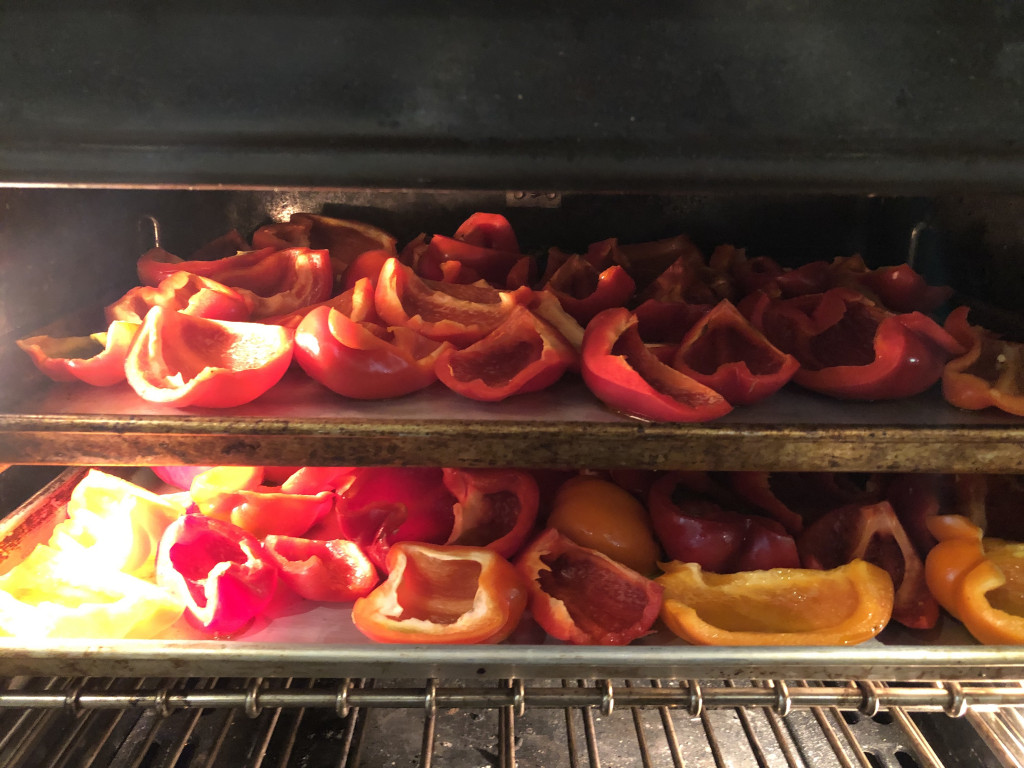

Home-roasted Red Peppers
My farmers market and nearby farm stands are overflowing with beautiful red, and even yellow and orange, peppers! Home-roasted red peppers might be the easiest and least time consuming way for you to dip your toe into the home food preservation waters. It’s a simple as 1, 2, 3!
- Wash and cut peppers into quarters, removing the stem, seeds, and inner white ribs
- Place on a baking sheet, drizzle with olive oil and roast at 450F until the skin starts to bubble and slightly blacken.
- Place into pint jars (each one will hold something like 3-5 peppers) and pop them into the freezer
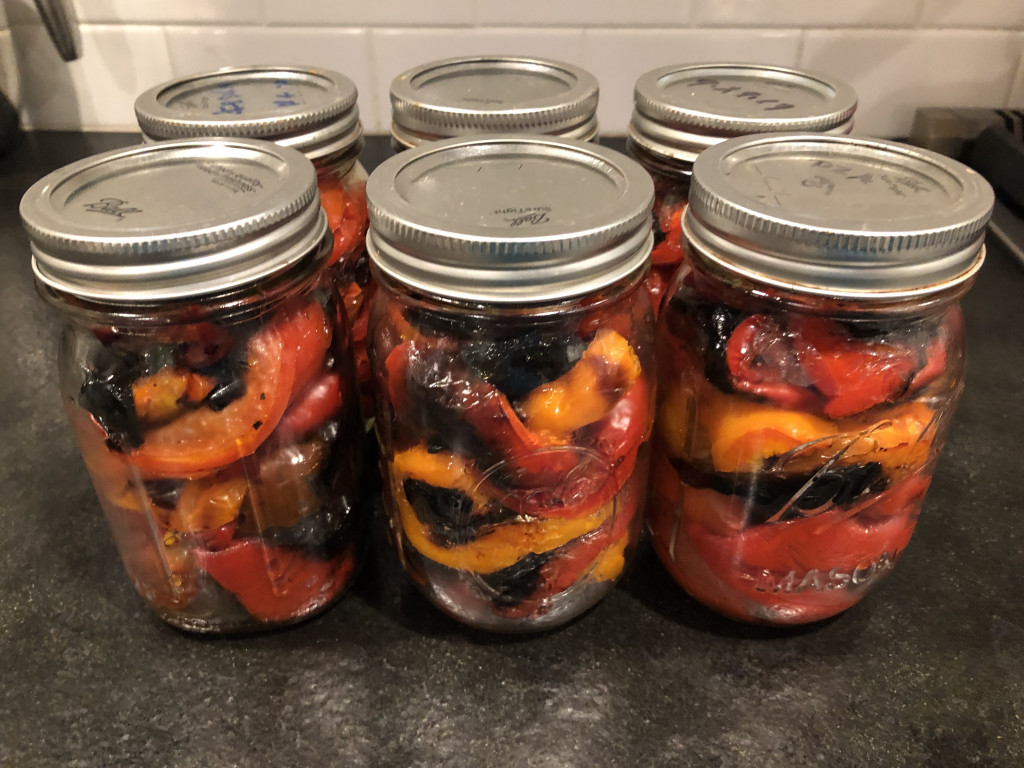
Roasted Red Pepper Curry Soup Recipe
(makes lunch/dinner for four to six people, leftovers are delicious too)
I have no idea where this recipe came from. I wish I could tell you the source, but I wrote it in my “favorite recipes book” and have been making it from there for the past couple of years. Apologies to the original author.
Download a printable PDF of this recipe here
Ingredients
- 2 teaspoons olive oil
- 2 cloves garlic, chopped roughly
- 1 inch ginger root, chopped roughly
- 3-4 red peppers, roasted in the oven as described above
- 1 quart (4 cups) vegetable or chicken stock
- 1 can coconut milk
- 3-4 Tablespoons red curry paste
- 2 Tablespoons soy sauce
- 2 Tablespoons lemon juice (lime would work just fine too)
Optional ingredients for topping (I recommend picking 3 or 4 of these)
- 1/4 cup cilantro, basil, or parsley, chopped
- 1 package of tofu, tossed in corn starch and pan fried in oil
- 1/2 package brown rice noodles (follow instructions on the package to cook)
- 1/2 cup peanuts, pistachios, or other favorite nuts, chopped
- Sriracha or other hot sauce
Instructions
- In a medium pot, saute garlic, ginger, and red peppers in olive oil on med-high heat until soft
- Add stock, coconut milk, curry paste, soy, and lemon juice. Bring to a boil
- Reduce heat to medium and cook for 5 minutes (longer is fine)
- Blend (I’ve used both an immersion blender and a countertop blender. Both work fine here)
- Optional: if you like a smoother soup, I recommend pouring it through a mesh sieve or strainer. If you don’t mind a chunky soup (or don’t have a sieve/strainer), you can skip this step.
- Salt and pepper to taste.
- Add your favorite toppings/stir ins from the options listed above or GET CREATIVE with what you have/love
- ENJOY!

Please share your comments, questions, and favorite toppings for this soup in the questions below! If you want to share gorgeous photos of your dinner, please tag me on Instagram and Facebook @carbonfreefamily. I LOVE seeing your beautiful photos!
]]>
As a child and through my early twenties, I firmly believed that I did NOT like tomatoes. Now that I’m a little older, I’ve come to understand that the tomatoes you can buy in the grocery store in February are a pathetic shell of the locally grown (in my garden or by a local farmer) summer tomato.
These days, I avoid fresh tomatoes like the plague for 10 months of the year until the magical tomato season arrives, right on schedule at the beginning of every August (here in Michigan). In this moment (yes, right now!), I eat ALL THE TOMATOES!
My favorite recipes for fresh tomatoes
This means the Augustine house is eating fresh tomatoes for nearly every meal. Some of my favorite “recipes” aren’t really even recipes at all, but rather a collection of delicious ingredients set near each other on a plate. The key to each of these is REALLY GOOD ingredients. If you haven’t already, now is a great time to seek out the best olive oil and balsamic vinegar you can find. My local favorite is a Spanish olive oil, called Arbiquina, that I can buy in bulk from a local shop called Old World Olive Company (Michigan friends, they have several locations around the state). My absolute favorite balsamic is from a farm in Texas, but we haven’t been able to get it in recent years, so I’m currently using an 18-year traditional balsamic, also from Old World Olive Company. I buy my burrata and fresh mozzarella (and pretty much every other cheese I eat) from my local cheese shop, the Rockford Cheese Shop.
My favorite “new” recipe is this gorgeous five ingredient tomato and burrata salad from Barefoot Contessa. After eating this salad almost every day in the past week (psst… it’s really delicious for breakfast!), my favorite combination is: tomatoes, burrata, olive oil, salt and pepper. Add basil (like in the photo below of the first time I made this yumminess, last weekend) or balsamic (like in the recipe linked above) if you feel like it. Or not. It’s completely up to you!

And the gateway Caprese salad (for many of us, including me, this is the first way people begin their love affair with tomatoes). Again, this “recipe” includes just a few fresh and simple ingredients… tomatoes, fresh mozzarella, and basil stacked in beautiful little piles, topped with balsamic vinegar, olive oil, salt, and pepper.

My favorite recipes to preserve tomatoes
I don’t know about you, but I can only eat so many tomatoes (just me? hmmm. Must be the 26 tomato plants we planted this year in our backyard veggie garden, but we can’t keep up!). Each year, in August and September, we spend countless hours in the kitchen preserving tomatoes so we can eat this delicious local food all year long.
Last year, I created a series of blogs focused on preserving food and collected them all into this free course. The course includes individual lessons that explain the basic preservation methods of canning, freezing, and dehydrating, and specific examples of how I use these preserving methods in combination to preserve tomatoes, corn and all my favorite foods so I can eat them all year long.
Whenever you’re ready, these recipes are here waiting for you. My favorite ways to preserve tomatoes include (follow the links below for more information and recipes):
- Freeze them whole (it’s just as simple as it sounds… I put whole tomatoes (no processing) into a ziploc bag and throw them straight into the freezer. These are good for soups and sauces throughout the year, but not slicing because the freezing breaks down the cellular structure, which is a fancy way of saying they’ll be mushy when you defrost them)
- Can them as diced, quartered, halved or whole
- Grandma’s tomato sauce (I can it, but you could just as easily freeze it)
- Sun dried tomatoes (perfect for freezing)
- Tomato paste (perfect for freezing)

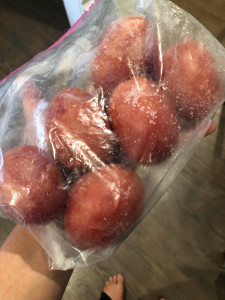
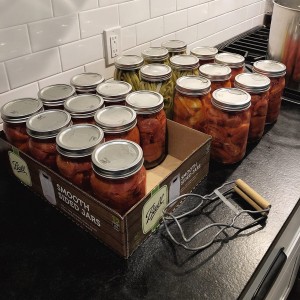
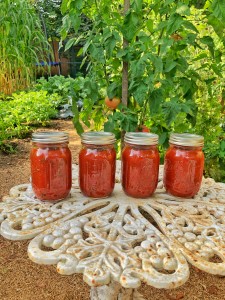
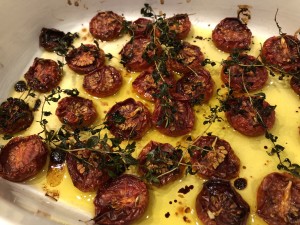

All of these recipes are delicious, but I have to tell you that homemade tomato paste changed my life! If you’ve never made your own I have to insist that you put it on your weekend “to do” list right now. This year. Before buying another single can of tomato paste. It’s truly that good. I can honestly say that I hope I never have to use the commercially made paste again.
Please share your thoughts, questions, and favorite recipes in the comments! How do you like to eat fresh tomatoes? How do you preserve them for later?
]]>
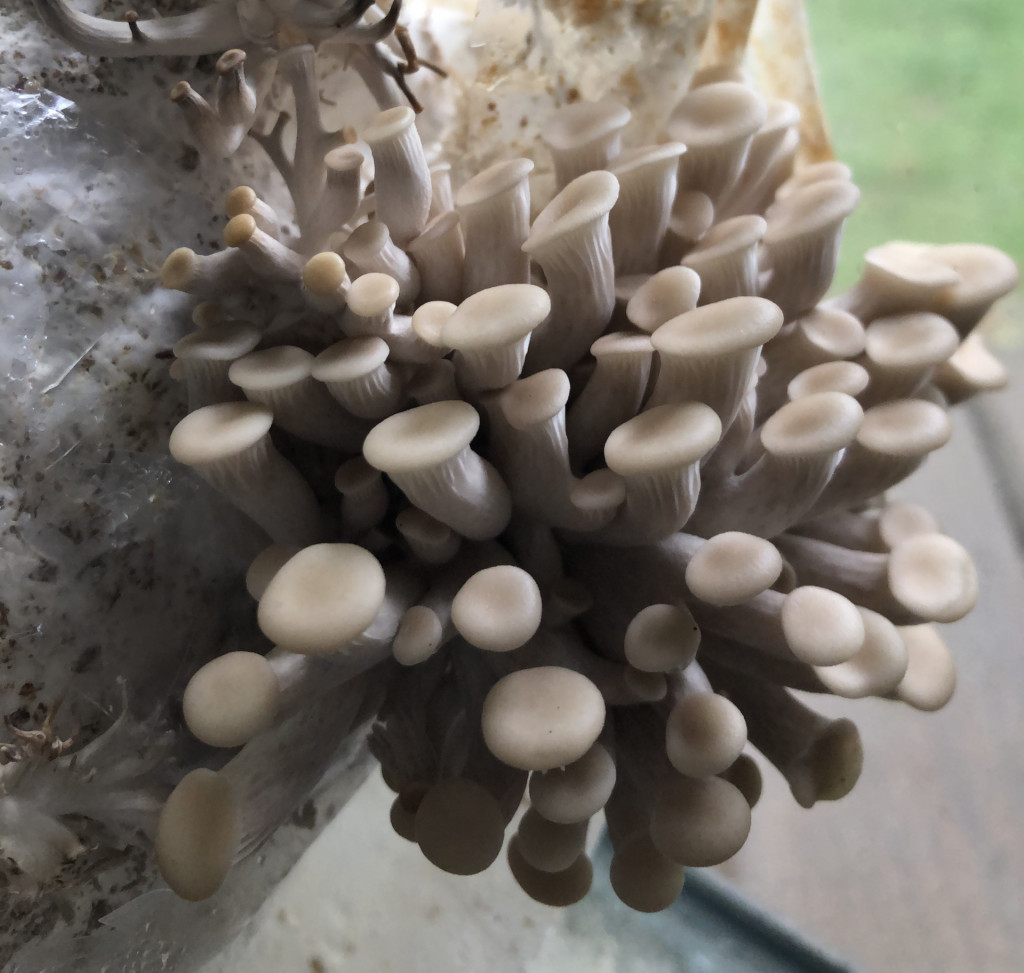
I struggled for a few minutes with the fact that the kits come in plastic bags, but like everything else, I’m embracing a #progressnotperfection attitude and looking for ways to eliminate the plastic bag in the future.
I’m growing oyster mushrooms using a grow kit from Mycophile’s Garden. They’re a mushroom farm located in Southwest Michigan and such a gift! I bought my first kit through West Michigan Farm Link (an awesome source for local food that I discovered this winter as I was trying to buy from more local farmers, even during the Michigan winter), but now they’re at my farmers market (and in Kalamazoo, Fulton Street, Grand Haven, St. Joe and others all over southwest Michigan), so I can easily restock. They also sell mushrooms by the pound, so you can pick some up tomorrow morning and make this salad for lunch!
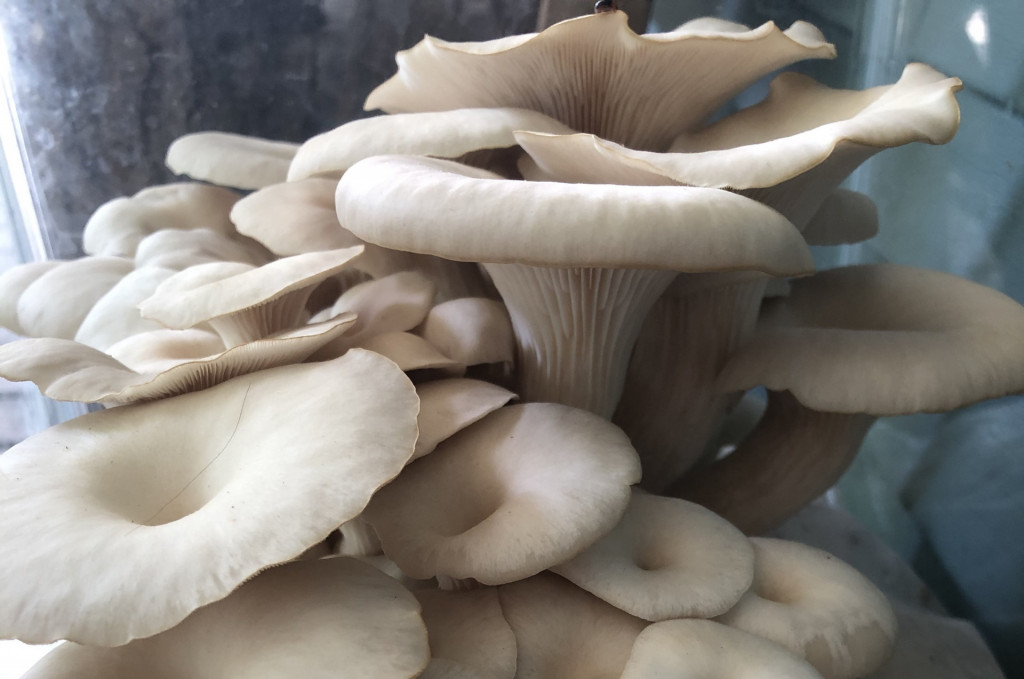
I paid $20 for my oyster mushroom kit and have already harvested 3 pounds of mushrooms! And mine is currently fruiting for the third time right now. It’s the little things like this that bring me so much joy! The kit comes with growing instructions and I’m shocked at how easy it has been to grow these beautiful and delicious oyster mushrooms.

I’m trying to branch out and find new recipes (so please send me your favorites in the comments or by email carbonfreefamily@gmail.com), but it’s hard to try new things when this warm mushroom salad is SO. DAMN. DELICIOUS! I made a disappointing mushroom pizza (with the homegrown oyster mushrooms) a couple of weeks ago and Robbie summed it up well when he said, “I mean this pizza is pretty good, but I’m comparing it to that amazing salad and I want the salad instead.”
I usually make the salad with oyster mushrooms and they’re still my favorite by far, but I’ve tried it with shiitakes and lions mane too and it was pretty good too. If you try it with other varietals, please come back and tell me about it!
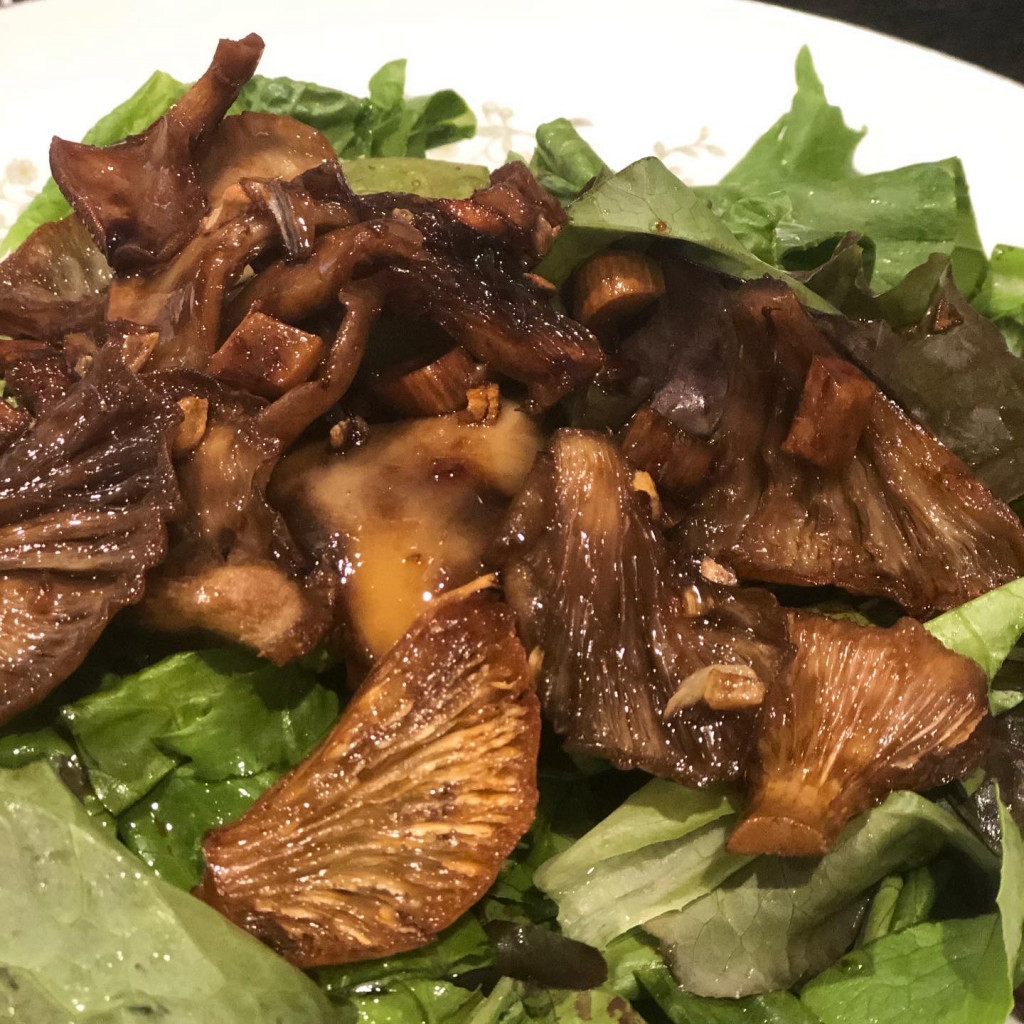
Recipe
(makes lunch/dinner salads for two or three people, more if you’re serving it as a side)
This recipe is adapted from Jamie Geller
Download a printable PDF of this recipe here
Ingredients
- 2 Tablespoons olive oil
- 1/2 to 1 pound mushrooms, cleaned and torn into pieces
- 2 garlic cloves, minced
- ¼ cup balsamic vinegar
- 3 cups salad greens (arugula works really nicely)
- salt + pepper
Instructions
- Clean your mushrooms. If they’re wild foraged and dirty, I recommend cleaning them as best you can without water, using a pastry brush, blowing the dirt off with your breath, or dusting it off with your fingers. Water changes the texture of mushrooms in a way thats unpleasant to me
- Tear them into large pieces. I read somewhere that the jagged edge makes them crisp up nicely and I’ve come to love the texture of torn mushrooms. If you have stems, chop them into small pieces.
- Heat olive oil over medium heat in a large saute pan, add mushrooms and cook, stirring occasionally until mushrooms are deep golden brown and have crispy edges, about 10 minutes.
- Add garlic and stir for just another minute to soften garlic a bit. Add balsamic and stir to coat mushrooms.
- Divide lettuce between 2-3 plates, top with warm mushrooms and drizzle with pan juices.
- Serve immediately and enjoy!
I can’t wait for you to come back and tell me how your mushrooms are growing! And if you like this salad! And if you tried it with other kinds of mushrooms!
]]>
I should start by telling you that our daily life is not designed around a car, not any car. I bike my 1.6 mile commute to work, every single day (yes, even in winter… just for fun, I’ve included a photo of my winter bike below). And Robbie stays home with the kids so he doesn’t have a daily commute to work. Our oldest daughter walks to school. Robbie and our youngest daughter have designed their daily life around walkable and bikeable destinations. I’m forever grateful for the fantastic walkability and bikeability of our sweet little town of Rockford, MI. We drive 20 minutes for groceries (not more than once per week) and about an hour to visit close family + friends (again, not more than once per week). So our routine car use is pretty much a perfect fit for an electric vehicle.
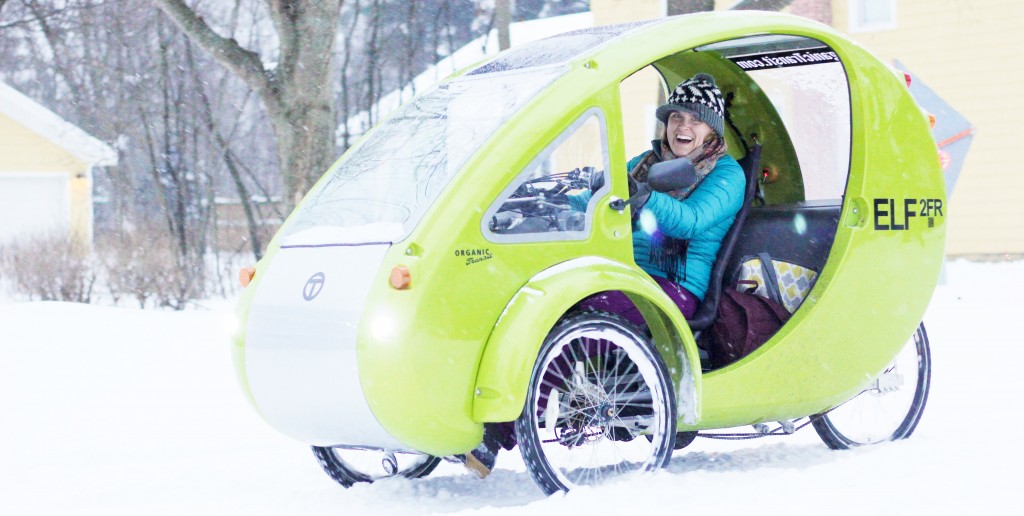
Let’s pivot to our Big Concern. Road trips. Full disclosure: I’m the worst roadtripper. Ever. More than a few hours and I turn into a whiny puddle of jelly in the front seat, asking “are we there yet?” more often than the children! So while this was our biggest concern, it still wasn’t that big of a deal because we usually fly somewhere far away or focus on finding adventure relatively close to home. Fast forward a few months after we bought the car… and here we are in the middle of a global pandemic and nobody’s flying, nowhere fast.
So, Spring Break 2021 was a family road trip to the Smoky Mountains National Park. We had a few major goals for this road trip:
- Drive the approximately 700 miles to our spring break destination
- HAVE FUN! (if you’re new to Carbon Free Family, you’ll quickly learn that this is always our top priority. We firmly believe that a more sustainable life can be fun!)
- Become more comfortable with charging our car while driving longer distances
- Arrive at our destination at or near the perfect check-in time at our AirBnB
We planned to take 2 days to drive the 700 miles from Rockford, Michigan to Hot Springs, NC and this trip went remarkably according to plan. The only planning I did ahead of time was to book our overnight hotel in Cincinnati. I picked the hotel specifically because they had two Tesla destination charging stations (I explain the difference between a supercharger and a destination charger in this FAQ blog). I was very pleased to learn that Marriott hotels lists electric charging stations in the “parking and transit” section of their hotel descriptions. I wish the brand would go one step further and include this in the “filters” so I can search specifically for hotels with charging stations (nudge, nudge @Marriott).

Away we go! Here’s what our first day looked like:
(you can follow along as if this were in real time in the “tesla EV” highlight on my Instagram)
2:15pm: Rockford, MI
We left the house at around 2:15pm with an 80% charge (237 miles). We weren’t at 100% because my daughter and I drove to our horse barn in the morning to sneak in a quick lesson before leaving for vacation. Ideally, we would leave the house with a full charge for a road trip like this, but life is all about compromise, right?
3:45pm:
We stopped for a potty break at 3:45pm. We didn’t need to charge yet, but… little bladders couldn’t hold it for 30 minutes to make it to the supercharger. Someday soon I’m certain there will be a EV charging station at every rest area and even our 15 minute potty break would recharge our battery a smidge.
4:30pm: Angola, MI
We stopped for our first charge of the trip in Angola, IN. We had about 55 miles of range left, so it was a pretty long charge. This was not my favorite charging station of the trip… slow speeds (only about 190 mi/hr or 55kW) and almost no amenities. Especially since we needed a big charge, I would have preferred a faster speed charger (you’ll see that sometimes we can get up to 400 miles/hour… this measurement is telling you the number of miles of charge gained by the battery per hour of charging). We stayed for about 45 minutes and left with 182 miles of range.
We like to plan our meals around charging stops, either popping into a grocery store to buy picnic supplies or ordering takeout from a nearby restaurant. In Angola, the charging station (a bank of 6 units) was located in an isolated strip mall with a motel and really small diner style restaurant. Maybe another time we’ll try the food, but this time we opted for soccer in the beautiful green space nearby. I would rate this stop 1/10 on speed and amenities, but 10/10 on green space. Check out the beautiful trail and field to play in!
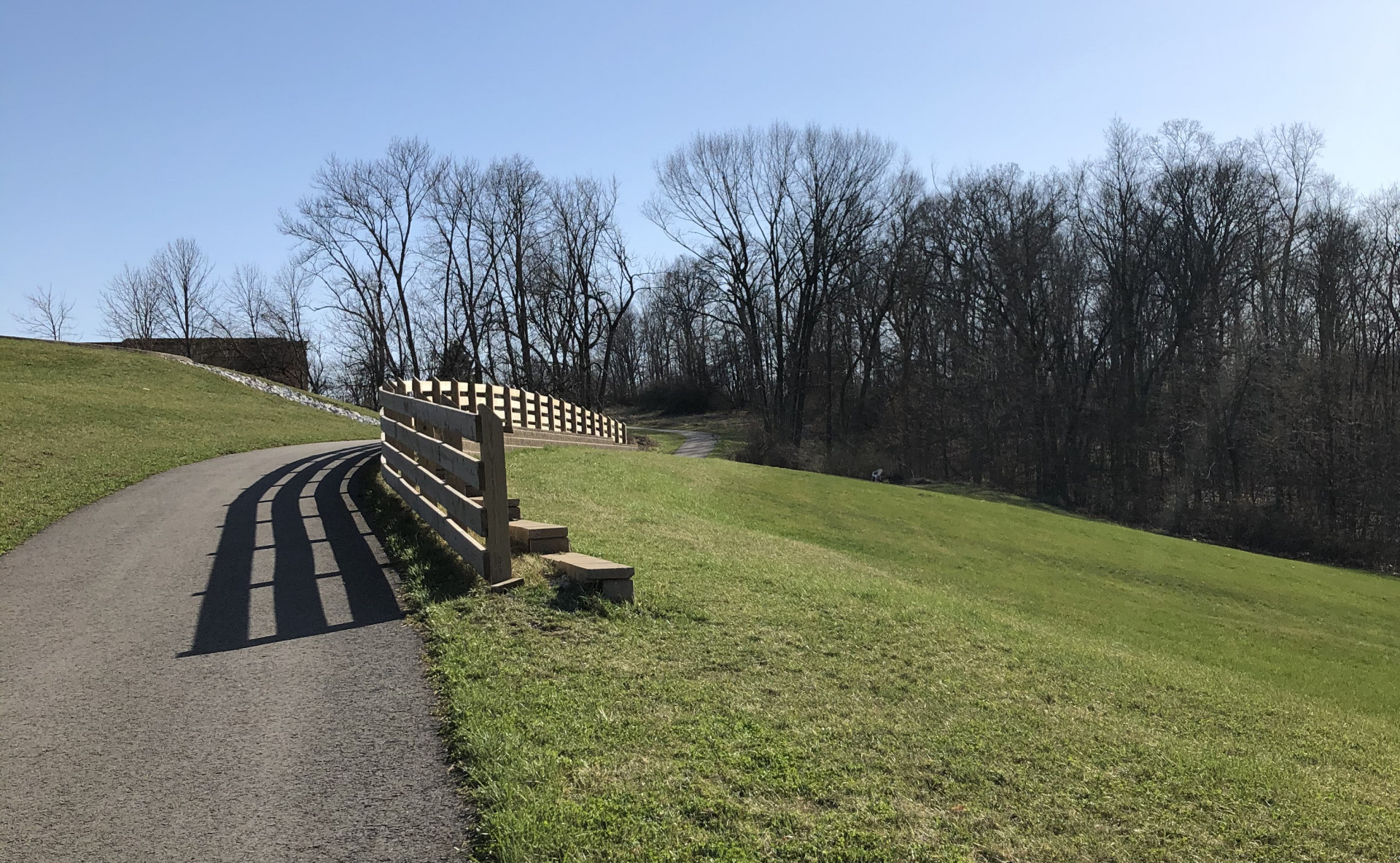
7:30pm: Lima, OH
We arrived with about 60 miles of range and were excited to find 8 spaces, only one other car, and fast charging speeds (between 320 and 350 mi/hr). This station was located in a very commercial area, with several hotels, restaurants, and not much green space. We walked through parking lots (no sidewalks… I should probably save it for another time, but I think there’s a real opportunity for areas near a charging station to be better designed for walkability) to a Panera Bread for snacks (for the kids) and a {decaf} cappuccino (for me) and to stretch our legs. Robbie played soccer with the kids in the hotel parking lot as the sun began to set. It was really a lovely scene. We stayed just long enough to gain enough charge to complete the remaining 135 miles to the hotel, around 40 minutes.
10:30pm: Cincinnati, OH
We arrived at our hotel happy and ready for bed. It took us just over 8 hours to drive 385 miles on the first day of our road trip. This is probably about an hour and a half longer than if we were death marching (meaning nascar style pee breaks with no time for play) in a gas-powered car. We don’t travel that way anyways, so for us this feels like slightly longer than it would have taken us in our old {gas-powered} car, but not noticeably longer.
We stayed at a Marriott and they had two Tesla charging stations + another non-tesla charger. The charging speed was slow (about 25 miles per hour), but slower speeds are fine for an overnight stop. We left in the morning around 9am with a full charge (251 miles… even more than when we left our house the previous day!).
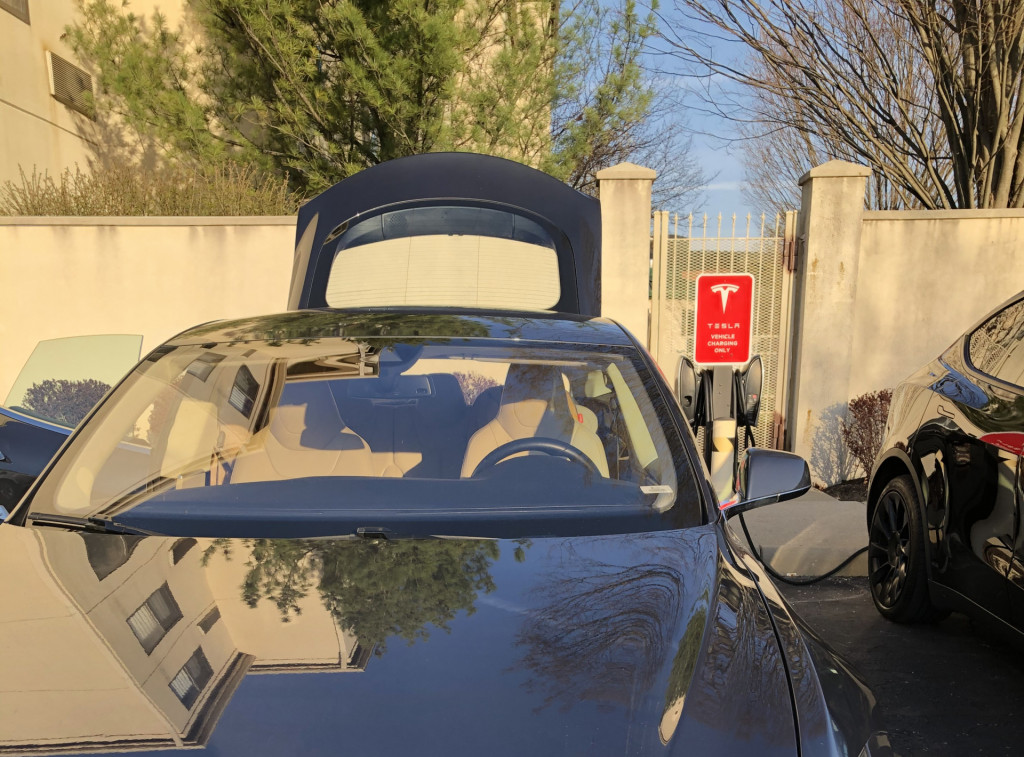
And we’re off again! Day 2 of our road trip:
9am: Cincinnati, OH
We only had 295 miles to go today and planned on making just one charging stop. We couldn’t check into our AirBnB until 3pm, so we took out time leaving the hotel.
11am: London, KY
This was the best charging stop of our trip! We knew we wanted to eat an early lunch, so I went online on my phone (from the highway) to look for a restaurant. There was a Cracker Barrel nearby so I placed an order online. Once we arrived, I took a nice little walk (again, no sidewalks though) to pick up our lunch while Robbie and the girls played soccer + set up a beautiful picnic space. This charging station had it all… green space to play, easily accessible bathrooms (in a tourist information center) and lots of restaurants to choose from. We took our time here and stayed about an hour, plenty of time for our car to completely charge up again.
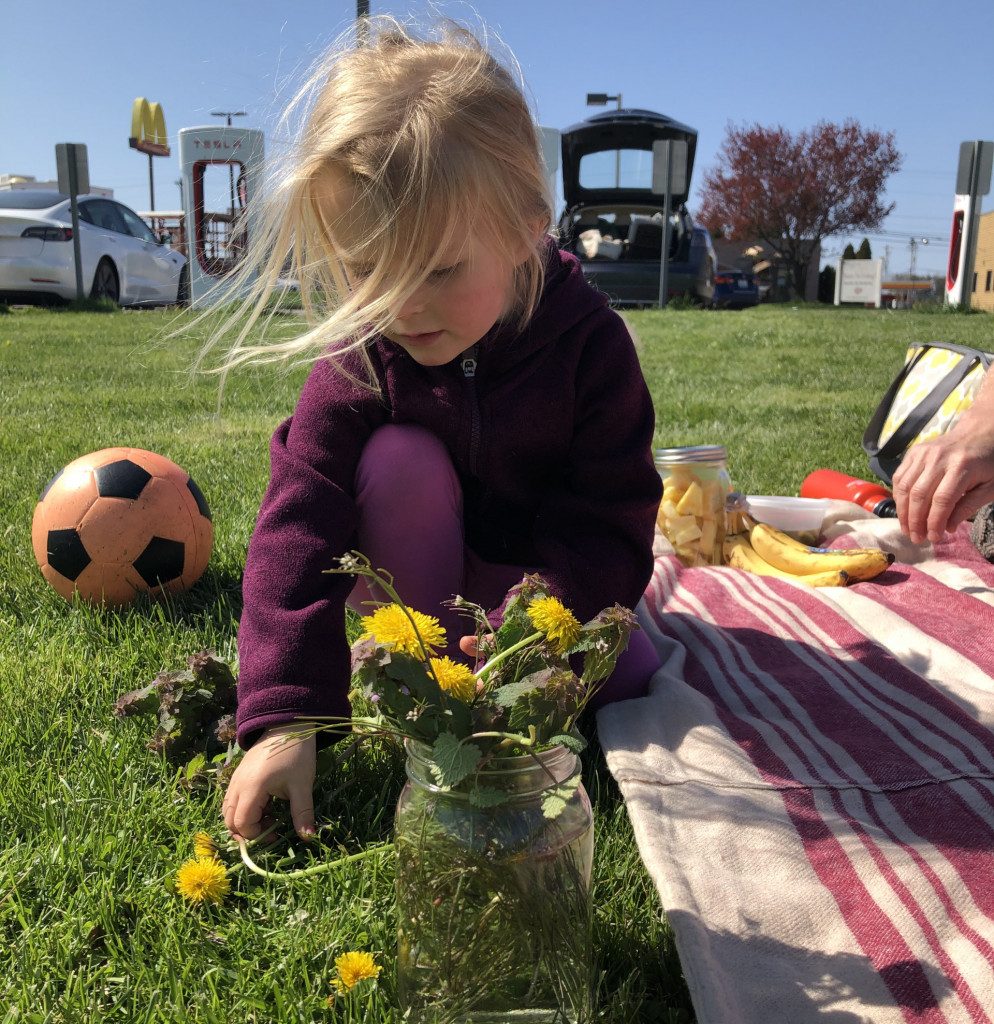
3pm: Hot Springs, NC
We arrived! Happy, healthy, relaxed, with plenty of charge left, and ready for a wonderful week in the North Carolina mountains!
But what about during vacation… I’ll admit that I didn’t really think about this when booking my family vacation in a tiny little town in the North Carolina mountains. We didn’t even ponder how we were going to recharge during the week until it magically popped into Robbie’s head a couple of days before we left. Thankfully, there was a charger in downtown Hot Springs, less than a half mile walk (on the Appalachian Trail, no less) from our rented home. Twice during the week, we used these charging stations at the Hot Springs Resort and Spa (and campground). These were destination chargers (again, see this FAQ blog for a full explanation of what this means) so they charged slowly, but we parked there overnight and it worked out just fine.
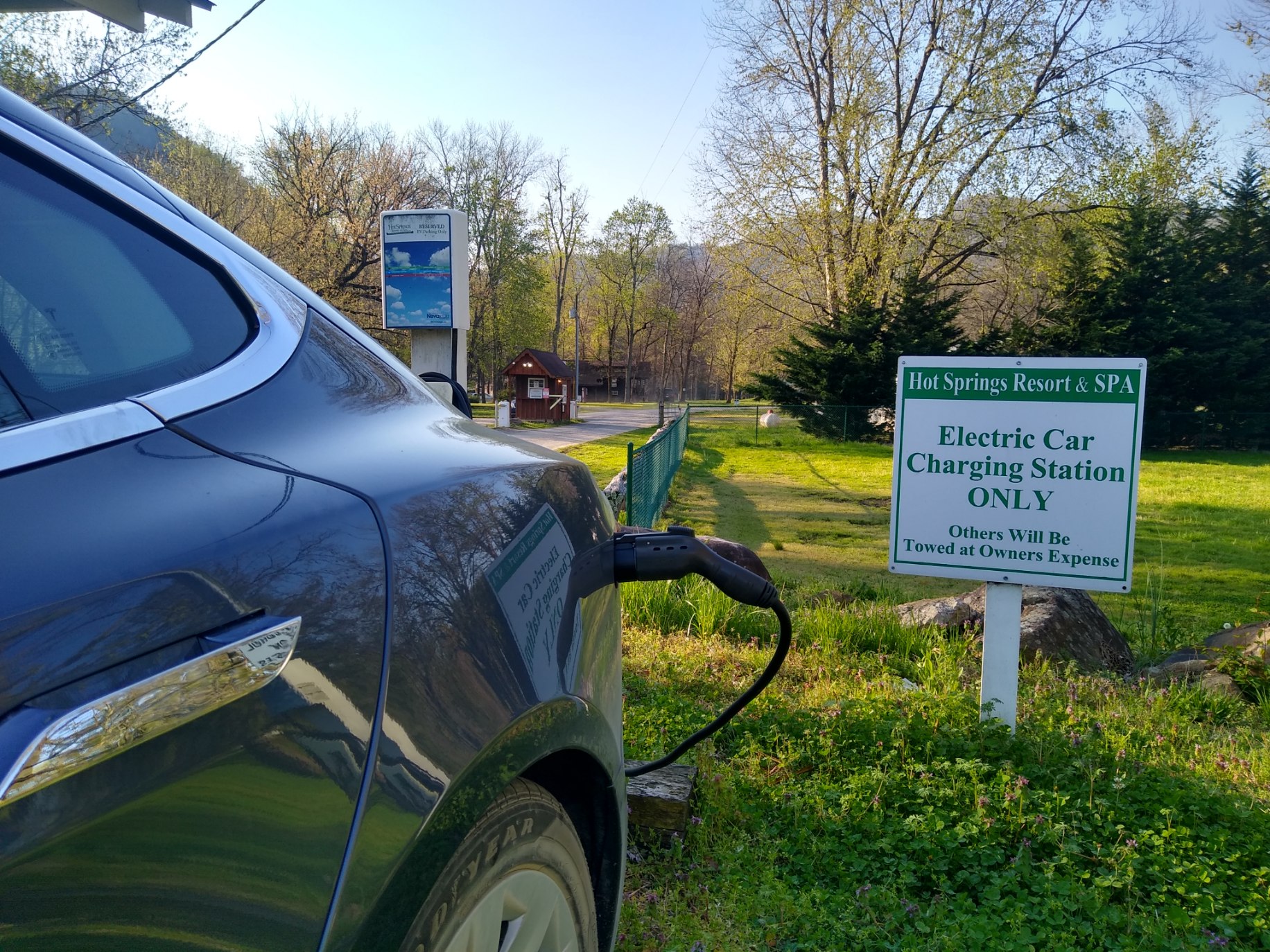
So what were my key takeaways from this first road trip in my new Tesla?
- It doesn’t take that much longer. In fact, pausing to recharge my car supports my intention to live a slower life. It encourages me to enjoy the little moments along the journey rather than racing to the destination.
- Plan ahead for food. Ordering on the road and having snacks in cases where food options are limited are both helpful strategies.
- Make sure there’s a charger at/near your vacation destination
Are you driving an electric car yet? If so, tell me about your charging adventures in the comments! If not, whats your biggest concern… what’s holding you back?
]]>

